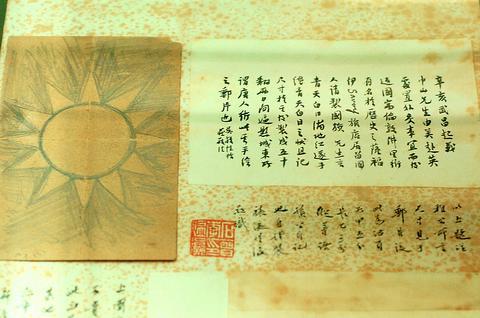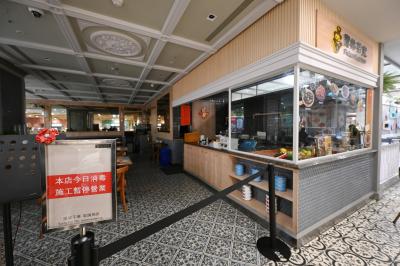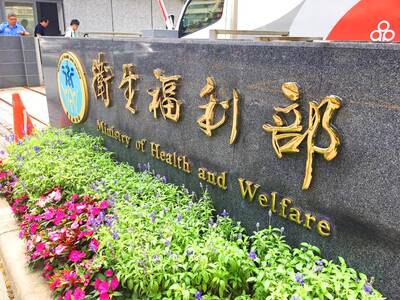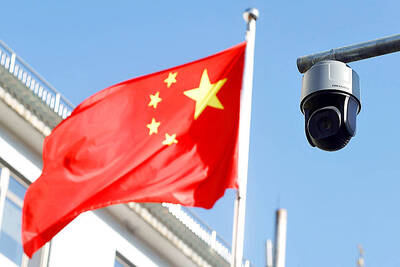The question of whether changes should be made to the Chinese Nationalist Party's (KMT) party emblem became the subject of controversy yesterday, with the Executive Yuan promising to revise the National Emblem Law (中華民國國徽國旗法) to allow the changes.
The KMT's emblem's similarity to Taiwan's national emblem -- and therefore the national flag -- became a hot topic of debate on Sunday night after President Chen Shui-bian (陳水扁) demanded the KMT change its emblem within three months to eliminate the confusion between the two symbols.

PHOTO: SEAN CHAO, TAIPEI TIMES
The KMT said yesterday that Chen's real problem was with the national emblem -- in keeping with his pro-independence tendencies. Party officials said the KMT would not give into pressure.
The Executive Yuan, however, said that it was looking for ways to revise the law to make sure the KMT falls in line.
The KMT's emblem features a 12-pointed white sun on a blue background symbolizing the sky.
The flag has the white sun-blue sky in its upper-left corner, with a crimson background.
While the government has no plans to change the flag, said Cabinet Spokesman Chen Chi-mai (陳其邁), the Executive Yuan will soon start work on revising the National Emblem Law.
Clarifying the president's position, Chen Chi-mai said the government is not going to change the flag but will instead see to it that the National Emblem Law is amended within three months to pave the way for it to legally require the KMT to change its emblem.
According to the National Emblem Law, the national flag belongs to the government of the Republic of China and should not be used "commercially" by anyone else, Chen Chi-mai said.
He also noted that the Trademark Act (商標法) stipulates that the national flag, national emblem or any pattern that is similar to the two cannot be used as logos or trademarks for any organization.
Based on this, he said, the KMT has been using its logo illegally.
KMT spokesman Chang Jung-kung (張榮恭) said the party didn't need to wait three months to give its answer.
"We can answer right now -- we will not change our party emblem. After political power changed hands in 2000, [the administration] changed the nation's emblem to the outside world. So Chen's goal should be to change the nation's emblem, not the party emblem," Chang said at the KMT's headquarters in Taipei.
"If Chen is unhappy that the national emblem is similar to the party emblem, then we welcome the Democratic Progressive Party [DPP] to embrace the national emblem in its party emblem," he said.
He said that since the DPP became the ruling party, the government has been slowly phasing out the use of the national emblem on official documents and its use by government agencies such as the Ministry of Foreign Affairs.
The KMT legislative caucus also said that the president should be taking issue with the national emblem instead of the KMT's -- even though it called his remarks mere election rhetoric.
At a press conference in the legislature yesterday KMT caucus whip Huang Teh-fu (黃德福) pointed to a poster displaying four different emblem and/or flag designs and called on the president to choose a new national emblem.
"All these flags have been proposed or used in the past. We give Chen Shui-bian three days to make a choice," Huang said.
The choices included the KMT party emblem, the national flag, a red, yellow, blue and white flag with black horizontal bars, and a flag similar to the current one but with a green background instead.
According to the Government Information Office's Web site, the five-color flag was used by the Shanghai army before 1911 to represent the five main ethnic groups of China.
According to Huang's research office, the flag with the green background was proposed in 1951 by Aboriginal groups as a possible national flag design.
Huang said that the difference between the national and KMT's emblems was clear because of the different size of the 12-pointed suns.
Huang said the KMT would not try to stop the government from changing the national emblem. He warned that the government would have to take full responsibility for the consequences of such a move, which the outside world might view as pro-independence.

POLAM KOPITIAM CASE: Of the two people still in hospital, one has undergone a liver transplant and is improving, while the other is being evaluated for a liver transplant A fourth person has died from bongkrek acid poisoning linked to the Polam Kopitiam (寶林茶室) restaurant in Taipei’s Far Eastern Sogo Xinyi A13 Department Store, the Ministry of Health and Welfare said yesterday, as two other people remain seriously ill in hospital. The first death was reported on March 24. The man had been 39 years old and had eaten at the restaurant on March 22. As more cases of suspected food poisoning involving people who had eaten at the restaurant were reported by hospitals on March 26, the ministry and the Taipei Department of Health launched an investigation. The Food and

A fourth person has died in a food poisoning outbreak linked to the Xinyi (信義) branch of Malaysian restaurant chain Polam Kopitiam (寶林茶室) in Taipei, Deputy Minister of Health and Welfare Victor Wang (王必勝) said on Monday. It was the second fatality in three days, after another was announced on Saturday. The 40-year-old woman experienced multiple organ failure in the early hours on Monday, and the family decided not to undergo emergency resuscitation, Wang said. She initially showed signs of improvement after seeking medical treatment for nausea, vomiting and diarrhea, but her condition worsened due to an infection, he said. Two others who

MEDICAL: The bills would also upgrade the status of the Ethical Guidelines Governing the Research of Human Embryos and Embryonic Stem Cell Research to law The Executive Yuan yesterday approved two bills to govern regenerative medicine that aim to boost development of the field. Taiwan would reach an important milestone in regenerative medicine development with passage of the regenerative medicine act and the regenerative medicine preparations ordinance, which would allow studies to proceed and treatments to be developed, Deputy Minister of Health and Welfare Victor Wang (王必勝) told reporters at a news conference after a Cabinet meeting. Regenerative treatments have been used for several conditions, including cancer — by regenerating blood cells — and restoring joint function in soft tissue, Wang said. The draft legislation requires regenerative treatments

Taiwanese should be mindful when visiting China, as Beijing in July is likely to tighten the implementation of policies on national security following the introduction of two regulations, a researcher said on Saturday. China on Friday unveiled the regulations governing the law enforcement and judicial activities of national security agencies. They would help crack down on “illegal” and “criminal” activities that Beijing considers to be endangering national security, according to reports by China’s state media. The definition of what constitutes a national security threat in China is vague, Taiwan Thinktank researcher Wu Se-chih (吳瑟致) said. The two procedural regulations are to provide Chinese